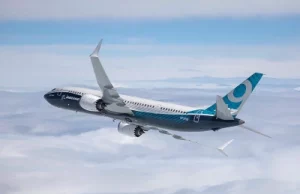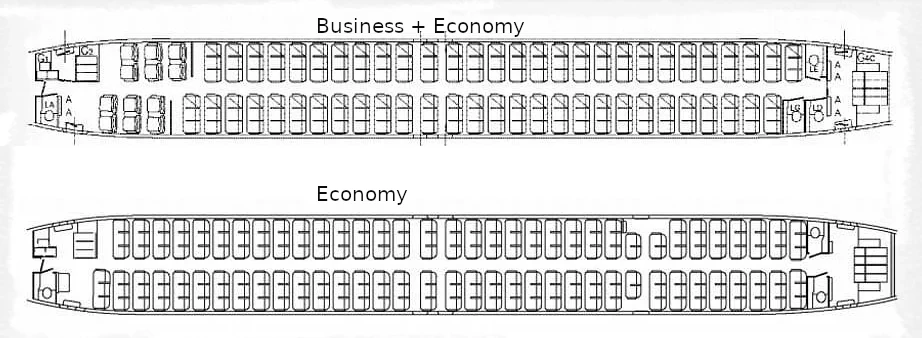About the Boeing MAX 737
The Boeing 737 MAX family is an evolution of aviation technology, combining innovation and efficiency to redefine the standards of narrow-body aircraft. Born from the legacy of the highly successful Boeing 737 series, the MAX variant embodies advancements in aerodynamics, engine technology, and avionics.
At the heart of the Boeing 737 MAX’s performance is its cutting-edge CFM International LEAP-1B engines, which contribute to enhanced fuel efficiency and reduced environmental impact. The reimagined wing design, featuring distinctive advanced winglets, not only adds to the aircraft’s aesthetic appeal but significantly improves its overall fuel economy.
This family of aircraft encompasses various models, each tailored to meet specific market demands. The Boeing 737 MAX Aircraft offer airlines a range of seating capacities and flight capabilities, ensuring versatility for diverse routes and passenger preferences.
The Boeing 737 MAX represents a commitment to safety and technological advancement. Following a period of challenges that led to a global grounding, Boeing undertook extensive measures to address concerns and enhance the aircraft’s systems. Rigorous testing and software updates have been implemented to ensure the MAX’s reliability and adherence to the highest safety standards.
As the aviation industry moves towards a more sustainable future, the Boeing MAX 737 stands as a beacon of progress. Its state-of-the-art features not only elevate the passenger experience but also underscore Boeing’s dedication to pushing the boundaries of what is possible in modern commercial aviation. The MAX family continues to soar, embodying a harmonious blend of tradition and innovation in the skies.
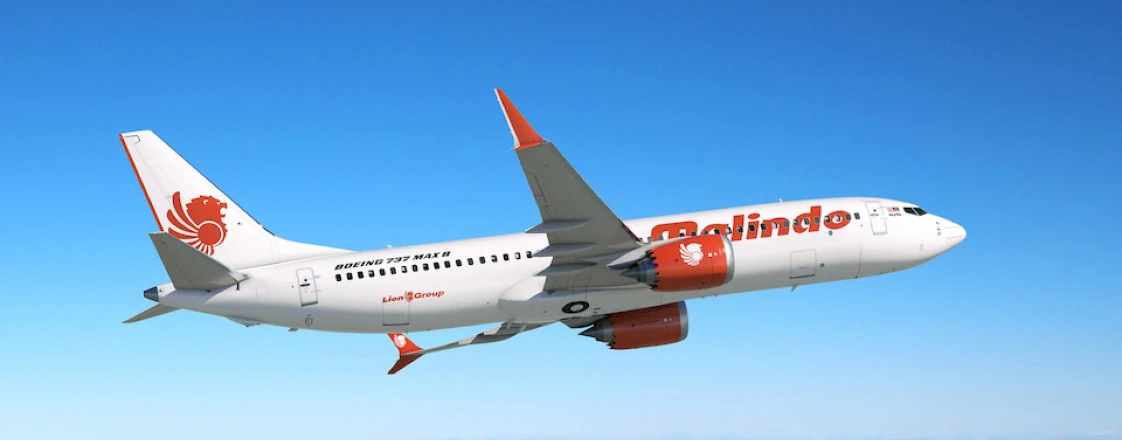
History of the Boeing 737 MAX Family
Boeing 737 airplanes have long been classics of passenger aviation. They have been modernized many times, reaching higher levels of reliability and safety. Continuous work was done to identify design flaws, materials were changed and shapes were refined. However, the fundamentals remained the same. The great-granddaddy of the airplane Boeing 737 Max, known to all Boeing 737, saw the light of day in 1967.
The history of the Boeing MAX 737 family began with its announcement in 2011, when Boeing announced its intention to develop a new generation of narrow-body passenger airplanes. The main goal was to introduce new technologies, improve efficiency and preserve the continuity of traditions established by the previous generations of Boeing 737.
Boeing’s main competitor is Airbus. As of 2010, Airbus engineers were actively developing the new A320Neo, of which Boeing had no analogs at that time. Boeing management decided to urgently create a competitor in the segment of medium-range commercial airliners, otherwise the company was threatened with irrevocable loss of market positions. Customers, who had been loyal to Boeing up to that point, were already planning to completely replace their flight crews with new Airbus aircraft.
This was the impetus for the start of work on the Boeing 737 MAX Aircraft. At first, the plan was to remotorize and refine the classic 737 NG. But in the process it became clear: in order to remain competitive, so many changes should be made to the classic that the output would be a completely new airplane.
The engineers had several goals in mind, the main one being to improve fuel efficiency. This is the parameter that airline customers pay attention to first and foremost. The work began with the modernization of the line at the aircraft construction site — a sure sign that a fundamentally new aircraft was expected. From 2013 to 2015, testing of the revamped 737 was underway. Finally, in 2015, Boeing Commercial Airplanes unveiled the new Boeing 737-8 MAX, the base model of the family.
In summer, the Boeing 737-8 MAX made its first commercial flight under the control of pilots of the Malaysian airline. In Russia, the airplane appeared quite recently: in October 2018. S7 Airlines became the owner of the aircraft.
Design Features
The MAX models differ from their predecessors:
-
- reduced fuel consumption due to quiet, fuel-efficient engines and 2.9 m high winglets (wing tips) with a special design;
- 20 cm larger front landing gear support;
- an exhaust gas cleaning system makes the Boeing 737 MAX 20 percent more environmentally friendly;
- innovative materials have reduced the weight of the airplane;
- redesigned lines increase aerodynamic drag;
- more comfortable cabin;
- new features in the cockpit: state-of-the-art equipment, large-format displays, ergonomic control panel.
Cockpit
Working in the Boeing 737 max cockpit is a real pleasure for the pilot. It is designed for a crew of two people. Each person has two large-format flat-screen monitors for assessing the situation during the flight. The airplane is equipped with surveillance cameras and its handling is really easy and reliable. All takeoff, landing and flight systems are redundant: if one fails, the other will be activated immediately.
Engineers took into account the comfort of pilots in the design, providing them with ergonomic seats, a convenient control panel and other nuances.
Engines
LEAP-1B from CFM International is an innovative development specifically for the 737 Max. Initially, the engines were planned only to be modified, taking as a basis the existing one on the Boeing 737 NG, but in the process of modernization a fundamentally new unit was created.
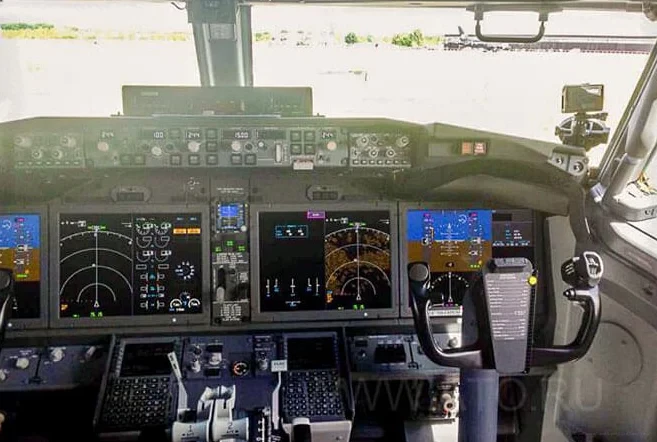
On-board electronics
The reliability of the control system is the foundation of aircraft safety. On the panel, as 40 years ago, there is a large number of buttons, toggle switches, gauges, lights and instruments that can only be understood by an experienced pilot. However, modern navigation and information displays enhance the pilot’s experience and give them a 21st century feel. Innovative on-board electronics simplify many tasks.
The latest flight recorders are installed on board the aircraft, which record data from modern computers.
Modifications of Boeing MAX 737
Boeing 737 MAX encompass various versions of this innovative narrow-body passenger aircraft, designed to meet the diverse requirements of airlines and enhance the flight capabilities of air transportation.
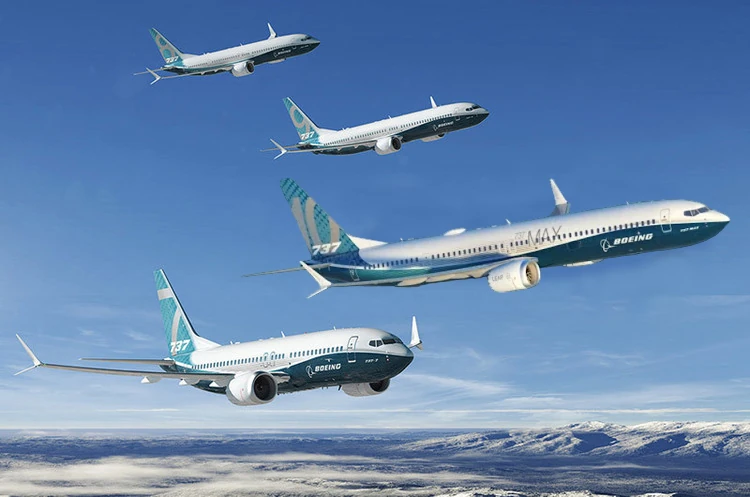
Boeing 737 MAX 7: The Boeing 737 MAX 7 is the most compact variant in the family. Its extended range and modest seating capacity make it an ideal choice for airlines operating on short to medium-haul routes.
Boeing 737 MAX 8: The Boeing 737 MAX 8 stands as one of the most popular variants. Engineered to strike an optimal balance between capacity and range, this aircraft is the preferred choice for many airlines conducting long-haul flights.
Boeing 737 MAX 9: Representing an enlarged version, the Boeing 737 MAX 9 offers additional passenger seating. With an elongated fuselage, this variant supports increased capacity and covers a broad spectrum of routes.
Boeing 737 MAX 10: The largest in the family, the Boeing 737 MAX 10 provides even greater seating capacity, making it an ideal choice for airlines focused on maximizing passenger load.
Regardless of size and route type, the Boeing 737 MAX Aircraft family offers modern technology, efficiency, and comfort, positioning itself as a key player in the world of commercial aviation.
Boeing MAX 737 Specifications
| 737 MAX 7 | 737 MAX 8 | 737 MAX 9 | 737 MAX 10 | ||
|---|---|---|---|---|---|
| Passenger Capacity | 172 (1 class) 138-153 (2 class) |
200 (1 class) 162-178 (2 class) |
220 (1 class) 178-193(2 class) |
230 (1 class) 188-204 (2 class) |
|
| Seat Pitch | 74 cm (1 class, standard) Two-class configuration — 76 cm economy and 91 cm business class |
74 cm (1 class, standard) Two-class configuration — 76 cm economy and 91 cm business class |
|||
| Length | 35.5 m | 39.5 m | 42.2 m | 43.8 m | |
| Wingspan | 35.9 m | ||||
| Height | 12.3 m | ||||
| Cruising Speed | 842 km/h (M 0.79) | ||||
| Maximum Zero Fuel Weight (MZFW) | 62,913 kg | 65,952 kg | 70,987 kg | 72,574 kg | |
| Maximum Takeoff Weight | 80,285 kg | 82,190 kg | 88,314 kg | 89,765 kg | |
| Maximum Landing Weight | 66,043 kg | 69,308 kg | 74,343 kg | 75,931 kg | |
| Range with Full Load | 7,130 km | 6,570 km | 6,570 km (additional fuel tank) |
6,110 km (additional fuel tank) |
|
| Fuel Capacity | 20,730 kg (25,816 liters) | ||||
| Engine Type | 2 × CFM International LEAP-1B. Maximum takeoff thrust 12,700 kgf (12,700×2 = 25,400 kgf). Bypass ratio — 9 | ||||
Boeing 737 MAX Seat Map
The developers conceived the interior space in such a way that it attracts passengers with its comfort, beauty and elegance of lines. The airplane has been updated with:
The cabin Boeing 737 MAX seat map clearly illustrates the changes in space: a wide aisle between rows of seats, comfortable luggage shelves, and ample legroom compared to other airplanes in this class. In general, MAX models combine business and economy class seats.
Business Class
Business class provides more comfortable conditions due to the larger space. The seats are unique — they are wider and softer than in economy class, and are arranged two per row, which gives the impression of a larger corridor between them. Each seat is equipped with a monitor, which can be called a full-fledged mini-computer.
The passenger can rest behind a screen and even sleep on the bed, which can be easily made from each seat. The length of the bed is longer than a standard home bed — 198 cm, which is especially convenient for tall passengers. The comfort of the flight is ensured with advanced design and engineering solutions.

Economy class
The most popular seats among passengers are located in economy class. Despite the budgetary nature of such a flight, it will be made in comfort. The main «feature» of Boeing 737 MAX is monitors built into the backs of the seats, on which you can watch movies and cartoons. Most economy class passengers have never seen such a service after buying a ticket at an affordable price.
Economy class has comfortable seats with various settings and leg room. The Boeing 737 MAX seating configuration is designed to maximize passenger comfort and optimize the overall layout of the cabin.Three seats in a row. Each passenger gets a pillow and blanket.
Choosing the Best Seats
Boeing claims that all seats in the new 737 MAX are the best. As standard for passenger airliners, increased legroom is found in the front rows and near the emergency exits. Models in the first row are equipped with a special cradle for a comfortable flight with an infant.
If you don’t manage to get a seat in the first row, don’t be upset. The flight will be comfortable even in the middle or tail of the airplane. As usual, the most comfortable seats are in Business Class.


